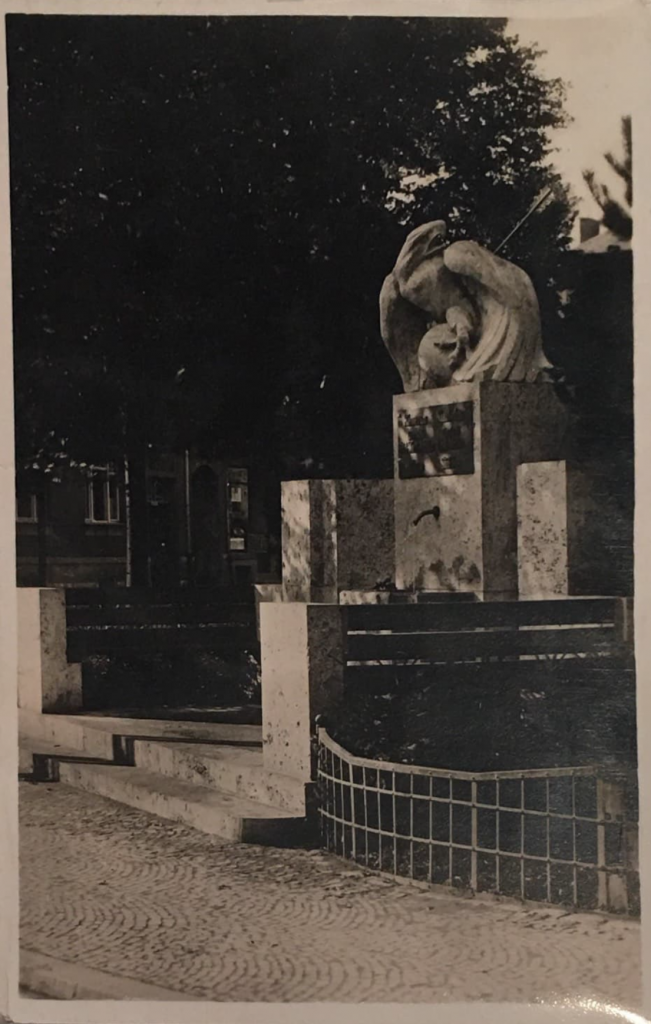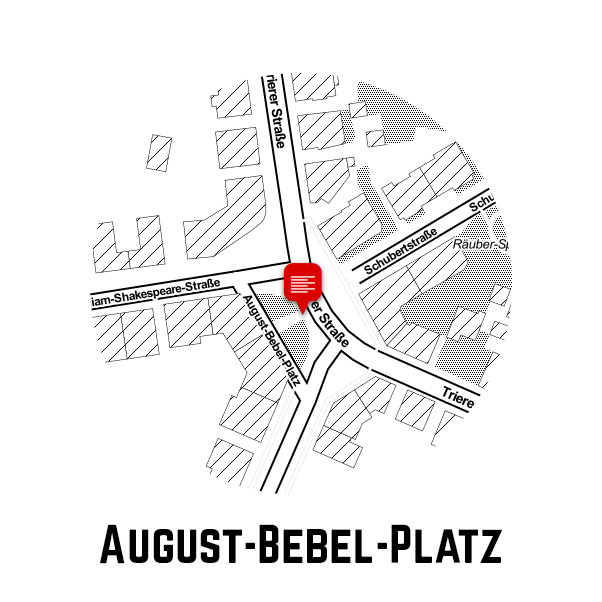Antonia Besel
This Station on Instagram
From September 6 to 8, 1930, the colonial conference of the Deutscher Kolonialkrieger-Bund (German Colonial Warrior's League) took place in Weimar. One of the "highlights" of this conference was the ceremonial inauguration of a colonial memorial fountain with numerous participants and supporters.[1] This colonial monument on August-Bebel-Platz, which has since been torn down, was an expression of a revanchist ideology that later also fueled National Socialism. Thirteen years after the Treaty of Versailles and the surrender of the German colonies, it symbolized the desire to regain the "protectorates".

Design and Symbolism of the Colonial Memorial Fountain
Support for the project of a colonial memorial fountain came largely from the state of Thuringia and its executive authority, the mayor of Weimar, Dr. Walter Felix Mueller.[2] The design of the fountain reflected the colonial ideology: on top of the fountain[3] stood the statue of an eagle sitting on a globe. An arrow is stuck in his wing and with his claws he holds[4] "German colonial land"[5], according to the Thüringer Landeszeitung of September 7, 1930. The eagle, which is a symbol of the German Empire, perched on the globe and clawed its supposed property with its claws. Despite being wounded by an arrow in its wing - symbolic of the Treaty of Versailles - it is holding on to the colonies. This clinging symbolizes the aspiration to regain the former colonies, as if the eagle had never let go of them.
The eagle and the globe came from the sculptor Josef Seife.[6] The names of Germany's former colonies were written on a sign on the the fountain's base.[7]
Reason for the Construction of the Colonial Memorial Fountain
The fountain was solemnly inaugurated on September 7, 1930. From various speeches, newspaper articles, letters and the conference agenda, it is still clear today how the conference weekend unfolded, who was involved and which colonial, nationalistic and increasingly fascist ideas were represented. The monuments erected during the colonization were intended to serve as reference points for the "New Germany" and thus give popularity to the colonial idea. After the German Reich had to cede its overseas possessions as a result of the First World War, monuments were to ensure that the German colonial empire, which had been "stolen" by the victorious powers, remained anchored in people's minds.[8] New monuments were also erected for this purpose, such as the Colonial Memorial Fountain discussed here. Closely connected with its construction is not only the German Colonial Warriors' League, but also the mayor of Weimar at that time, Dr. Mueller, who held office from March 29, 1920 to September 30, 1937.[9]
Mayor Mueller is welcoming the Colonial Warriors' League
On August 20, 1930, Police Chief Constable Flamm and the press received a welcome from that same mayor. In it he warmly welcomed the German Colonial Warriors' League to the Thuringian capital. He announced that on the occasion of the meeting the colonial memorial fountain at the then Bismarckplatz, today August-Bebel-Platz, was to be inaugurated. It was the result of a joint effort of the League and the city and should express that "[...] also in the city of Weimar the colonial idea is alive and should be kept alive for the future despite [...] political and economic hardships."[10] He added that for Germany, as well as for all other European powers, overseas bases were extremely important for economic and ideological reasons. In addition, he insisted that a claim should be made for the return of " their own" colonies. The work of the Colonial Warriors' League in Weimar was also to "serve the colonial idea".[11] Mueller also addressed a personal letter to the League once again, expressing his "most obliged gratitude"[12] and added that he was "happy to accept the invitation".[13] werde.[14]
Newspaper Article about the Inauguration of the Colonial Memorial Fountain
The Colonial Conference begins on Saturday, September 6, 1930, at 10 a.m. with a presidential meeting in the Colonial Home. On Sunday, September 7, 1930, at 3 o'clock in the afternoon, the Colonial Memorial Fountain in Weimar is inaugurated, accompanied by speeches of the Lieutenant General Ritter von Epp and the Mayor Mueller.[15] On the same day, the Allgemeine Thüringische Landeszeitung once again writes clearly what can already be read between the lines of the welcome. "The annual meeting of the German Colonial Warriors' League [...] [shall] primarily serve the work for the reconstruction of German colonial power [...]"[16] In the newspaper section about the colonial conference it can be read repeatedly that Germany needed colonies and the return of "our" colonies is clearly demanded: Without them, a German Empire would be unthinkable since it was dependent on the raw materials from the colonies. If the lands were not returned to Germany, overpopulation, poverty and further misery in Germany would be fueled. In the texts, Germany is portrayed as a victim. The Germans were "wage slaves" to the great colonial powers, since colonies were "withheld" from them. Throughout the weekend, German soldiers who had fallen in Africa were also repeatedly commemorated. They were referred to as "colonial heroes" and honored in a special way.[17] There is no mention anywhere of colonial crimes such as repression, expulsion, war and the genocide of the Herero and Nama. The state government of Thuringia takes a firm stance: Minister of State Baum states in the Allgemeine Thüringische Landeszeitung that the state government[18] „[will] support and promote all efforts to regain the colonial possessions of which [Germany] had been unjustly deprived."[19]
Correspondence between Mayor Dr. Mueller and the German Colonial Warriors' League
After the unveiling of the colonial memorial fountain, two more letters from the German Colonial Warriors' League reach the mayor, Dr. Mueller. The first one is dated September 13, 1930 and once again explicitly thanks the mayor and his city administration for the construction of the colonial memorial fountain. They are particularly pleased that "Weimar shows such understanding and interest in colonial necessities and encourages colonial publicity."[20] Anyone who drinks water from the fountain or just looks at it is supposed to commemorate the former colonies. Here we can see once again how positive the memory of the colonies in the Weimar Republic is. It is accompanied by a mourning for the loss of the colonies. The suffering of the indigenous people who lived and had lived in the colonies and the colonial crimes against them are disregarded and not mentioned with a word. The possession of colonies is glorified and their loss is accompanied by a constructed victimization of Germany.
The text also shows how much Dr. Mueller supported the Weimar Colonial Society.[21] In the second letter to Dr. Mueller, the vice president of the German Colonial Warriors' League, Mr. Lowe, now addresses him personally. Here, too, it becomes apparent how much the Mayor participated in the design of the colonial memorial fountain. Lowe also reflects how active Weimar already took part in the Erfurt Conference in 1921, "the first impetus to activate the col. thought"[22] He also writes that Weimar would now be the first German city to openly embrace the ideologies of colonialism by erecting the Colonial Memorial Fountain.[23]
From all texts it is quite evident that the city of Weimar and especially Mayor Dr. Mueller clearly represented the colonial ideology and also supported it financially and materially. Without them, the meeting of the German Colonial Warriors' League in this form would not have been possible. Also the construction of the colonial memorial fountain can be traced back to the initiative of the city of Weimar and seemed to be a gift to the German Colonial Warriors' League.
The monument can no longer be found in Weimar today. In the GDR, all colonial monuments known to the government have been destroyed since 1945. This took place within the context of[24] "the dismantling of Germany's outdated 'imperialist legacy'.'"[25]
The August-Bebel-Platz today
Today, August-Bebel-Platz is rather relegated to the background in Weimar's cityscape. The GDR's treatment of places of remembrance of German colonialism must be viewed critically. Instead of using places like this for critical remembrance of German colonial rule and framing, contextualizing and critically dealing with monuments, the colonial fountain was made to disappear without replacement. A review of the subject matter and related educational work would have been desirable. As a result, most people today no longer know how closely Weimar was connected with colonialism. In this context, a new monument at August-Bebel-Platz, dedicated to the victims of German colonialism would also be conceivable.
Sources
- Van der Heyden, Ulrich; Zeller, Joachim (2007): Kolonialismus hierzulande – Eine Spurensuche in Deutschland. Erfurt: Sutton Verlag GmbH.
- o.V.: Weimars Stadtoberhäupter seit 1793. In: stadt.weimar.de, URL: https://stadt.weimar.de/ueber-weimar/stadtgeschichte/oberbuergermeister/, accessed: 05.02.2020
- Willkommensgruß, Tagesordnung, Allgemeine Thür. Landeszeitung: 7. September 1930, Brief: Deutscher Kolonialkrieger-Bund an Herrn Oberbürgermeister Dr. Mueller 13.9.30 und Brief: Lowe an Oberbürgermeister Dr. Mueller stammen aus dem Stadtarchiv Ordner mit der Signatur: 12/1-12-18
Endnotes
[1] Cf. Tagesordnung, An: 12/1-12-18
[2] Cf. Tagesordnung, An: 12/1-12-18
[3] Der Entwurf stammt von Stadtoberbaurat Lehrmann und wurde vom Architekten Saalborn aus dem Gestein Travertin hergestellt.
[4] Cf. Allgemeine Thür. Landeszeitung: 7. September 1930, An: 12/1-12-18
[5] Allgemeine Thür. Landeszeitung: 7. September 1930, An: 12/1-12-18
[6] Cf. Allgemeine Thür. Landeszeitung: 7. September 1930, An: 12/1-12-18
[7] Cf. Brief: Deutscher Kolonialkrieger-Bund an Herrn Oberbürgermeister Dr. Mueller 13.9.30, An: 12/1-12-18
[8] Cf. Van der Heyden/Zeller 2007: 267
[9] Cf. Website
[10] Willkommensgruß, An: 12/1-12-18
[11] Willkommensgruß, An: 12/1-12-18
[12] Willkommensgruß, An: 12/1-12-18
[13] Willkommensgruß, An: 12/1-12-18
[14] Cf. Willkommensgruß, An: 12/1-12-18
[15] Cf. Tagesordnung, An: 12/1-12-18
[16] Allgemeine Thür. Landeszeitung: 7. September 1930, An: 12/1-12-18
[17] Cf. Allgemeine Thür. Landeszeitung: 7. September 1930, An: 12/1-12-18
[18] Cf. Allgemeine Thür. Landeszeitung: 7. September 1930, An: 12/1-12-18
[19] Allgemeine Thür. Landeszeitung: 7. September 1930, An: 12/1-12-18
[20] Brief: Deutscher Kolonialkrieger-Bund an Herrn Oberbürgermeister Dr. Mueller 13.9.30, An: 12/1-12-18
[21] Cf. Brief: Deutscher Kolonialkrieger-Bund an Herrn Oberbürgermeister Dr. Mueller 13.9.30, An: 12/1-12-18
[22] Brief: Lowe an Oberbürgermeister Dr. Mueller, An: 12/1-12-18
[23] Cf. Brief: Lowe an Oberbürgermeister Dr. Mueller, An: 12/1-12-18
[24] Cf. Van der Heyden/Zeller 2007: 267
[25] Van der Heyden/Zeller 2007: 267
